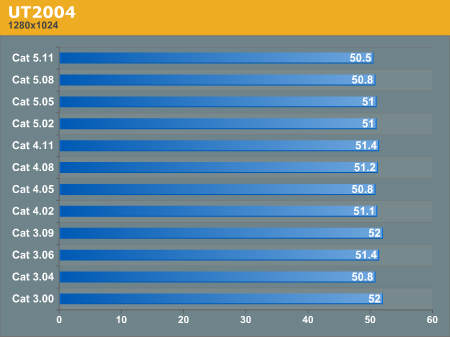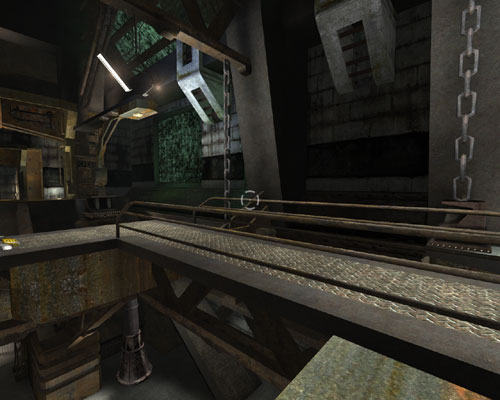Looking Back: ATI's Catalyst Drivers Exposed
by Ryan Smith on December 11, 2005 3:22 PM EST- Posted in
- GPUs
Unreal Tournament 2004
As UT2003 and UT2004 are near-perfect substitutes for each other, we went with Epic's latest version of their best-selling multi-player FPS in order to put the 9700 Pro up against 2004's more refined engine. UT2004 is a good example of a near-modern game, utilizing some SM 1.x features, along with being the engine of choice for many more games, including America's Army. With the number of games built on the Unreal Engine 2.x, UT2004 represents an important engine to optimize for, given the era.
Other than improving AA/AF performance, it seems that ATI had little need to optimize for UT2004. Without a performance or IQ difference, there is little to say about the 9700 Pro with regards to UT2004.
As UT2003 and UT2004 are near-perfect substitutes for each other, we went with Epic's latest version of their best-selling multi-player FPS in order to put the 9700 Pro up against 2004's more refined engine. UT2004 is a good example of a near-modern game, utilizing some SM 1.x features, along with being the engine of choice for many more games, including America's Army. With the number of games built on the Unreal Engine 2.x, UT2004 represents an important engine to optimize for, given the era.



Catalyst 5.11 versus 3.00 (mouse over to see 3.00)
Other than improving AA/AF performance, it seems that ATI had little need to optimize for UT2004. Without a performance or IQ difference, there is little to say about the 9700 Pro with regards to UT2004.










58 Comments
View All Comments
Ryan Smith - Sunday, December 11, 2005 - link
With this article series, we're especially looking for feedback guys. We can't test every last game under the sun because of how long it would take, but if there's something you guys would like to see and a good reason for it, we'd like to hear about it for possible inclusion in a future regression.Questar - Monday, December 12, 2005 - link
Feedback?Learn to proofread.
Cygni - Tuesday, December 13, 2005 - link
Feedback?Dont be an asshole.
Scrogneugneu - Monday, December 12, 2005 - link
I would like to see that kind of test on another, more recent card.Why? Simply to test what the first driver revisions do in term of performance. The article already shows that later in the driver's life, there is little improvement made on performance... but that on early drivers, there is usually a good jump. Could it be possible to test with a newer card, with the drivers available at launch and up from there?
That way we could have a better idea of what to expect when we hear ATI or NVidia saying "we will optimise the drivers after the launch". Does every optimisation happens in the first release, the second, the five first... what release usually brings the best improvements, both on IQ and FPS?
Could be nice to see such an article :)
timmiser - Tuesday, December 13, 2005 - link
I don't think that would work because the older drivers (ie-Cat 3.0, Cat 4.0) won't support the newer card.Scrogneugneu - Tuesday, December 13, 2005 - link
Well, if you use the drivers available at the launch of the card up to the current release, I'm pretty sure they will all be compatible with the card, won't they? ;)The goal is not to see what improvements were made with Catalyst 3.0 to 5.12, but to see what improvements were made from the first driver available for the card to the latest. More importantly, to see WHEN were they made.
timmiser - Tuesday, December 13, 2005 - link
Well yes, you could do that, but then you have just a typical article about driver improvements over the last 5 or 6 months which every hardware site has done over and over again. What makes this article unique is they take an older video card and review older drivers so that we can see the driver improvement effect over the span of years instead of months.Scrogneugneu - Wednesday, December 14, 2005 - link
By more recent card, I didn't mean a ATI X1x00 card or a NVidia 7x00.I was more talking about something like the Xx00 series. These cards have seen a great number of driver release, and are still pretty recent.
Besides, this article showed us that the only improvements seen were generally at the early stage of the development of the drivers, or at that least later in the works, there's not much difference. So, we can assume that a year of different driver revisions would be enough to show us what kind of improvements are made.
timmiser - Wednesday, December 14, 2005 - link
Exactly, which is all information we didn't know until this article showed that.oopyseohs - Sunday, December 11, 2005 - link
The Athlon64 you used was socket 754, not 757. =]